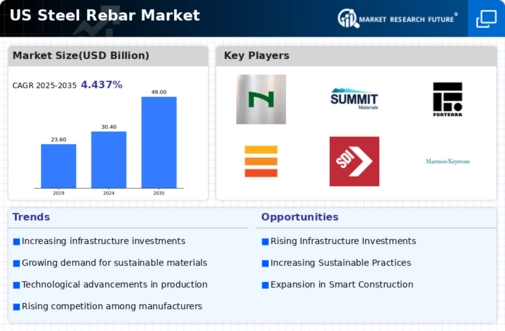The steel rebar market in the US is characterized by a competitive landscape that is both dynamic and multifaceted. Key growth drivers include increasing infrastructure investments, a resurgence in construction activities, and a heightened focus on sustainability. Major players such as Nucor Corporation (US), Steel Dynamics, Inc. (US), and Gerdau Ameristeel Corporation (US) are strategically positioned to leverage these trends. Nucor Corporation (US) emphasizes innovation in production processes, particularly through its use of electric arc furnaces, which enhances efficiency and reduces environmental impact. Steel Dynamics, Inc. (US) focuses on regional expansion and supply chain optimization, while Gerdau Ameristeel Corporation (US) is enhancing its operational capabilities through strategic partnerships aimed at improving product offerings and market reach.
The business tactics employed by these companies reflect a concerted effort to localize manufacturing and optimize supply chains, which is crucial in a moderately fragmented market. The collective influence of these key players shapes a competitive structure that encourages innovation and responsiveness to market demands. As companies strive to differentiate themselves, the emphasis on localized production and efficient logistics becomes increasingly apparent, allowing them to better serve regional markets and reduce lead times.
In November 2025, Nucor Corporation (US) announced a significant investment in a new rebar manufacturing facility in Texas, aimed at increasing production capacity by 30%. This strategic move is expected to enhance Nucor's ability to meet the growing demand for rebar in the southern US, particularly in light of ongoing infrastructure projects. The investment underscores Nucor's commitment to maintaining its competitive edge through capacity expansion and localized production.
In October 2025, Steel Dynamics, Inc. (US) entered into a joint venture with a local construction firm to develop a new line of sustainable rebar products. This collaboration is indicative of Steel Dynamics' focus on sustainability and innovation, as it seeks to align its product offerings with the increasing demand for environmentally friendly construction materials. The joint venture is likely to enhance the company's market position by appealing to eco-conscious consumers and contractors.
In September 2025, Gerdau Ameristeel Corporation (US) launched a new digital platform aimed at streamlining the ordering process for contractors and construction firms. This initiative reflects Gerdau's commitment to digital transformation, enhancing customer experience and operational efficiency. By integrating technology into its business model, Gerdau positions itself as a forward-thinking player in the market, likely attracting a broader customer base.
As of December 2025, current competitive trends in the steel rebar market are increasingly defined by digitalization, sustainability, and the integration of advanced technologies such as AI. Strategic alliances are becoming pivotal in shaping the landscape, as companies collaborate to enhance product offerings and operational efficiencies. Looking ahead, competitive differentiation is expected to evolve, with a shift from traditional price-based competition towards innovation, technology adoption, and supply chain reliability. This transition may redefine market dynamics, compelling companies to invest in R&D and sustainable practices to maintain their competitive positions.



















Leave a Comment